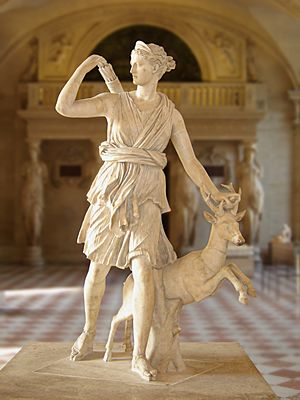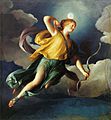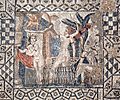Diana (mythology) facts for kids

In Roman mythology, Diana was a powerful goddess. She was known as the goddess of hunting. Later, people also saw her as the goddess of the moon and chastity (meaning purity). Cypress trees were special to her.
Diana was the daughter of Jupiter, the king of the gods, and the Titan Latona. Her twin brother was Apollo. In Greek mythology, Diana was known as Artemis. She was also connected to fertility and nature.
Who Was Diana?
Diana was born with her twin brother, Apollo, on the island of Delos. Apollo was her only full brother. However, she had many half-siblings from her father, Jupiter. These included Vulcan, Minerva, Mercury, Bacchus, Mars, and Proserpine.
Diana was part of a special group of three Roman deities. The others were Egeria, a water nymph who helped her, and Virbius, the god of the woods. Diana was a "maiden goddess." This means she chose never to marry.
What Was She Known For?
Diana was mostly known for hunting. She was often shown with a bow and arrows, and sometimes with a deer or hunting dogs. As the goddess of the moon, she brought light to the night. Her connection to nature meant she protected wild animals and forests.
She was also a symbol of purity and independence. Many stories show her as strong and free. People prayed to Diana for help with hunting, for protection in nature, and for fertility.
Images for kids
-
Statue of Diana-Artemis, fresco from Pompeii, 50-1 BCE
-
Diana as Personification of the Night. Anton Raphael Mengs, c. 1765.
-
An ancient Fourth-Pompeian-Style Roman wall painting depicting a scene of sacrifice in honor of the goddess Diana; she is seen here accompanied by a deer. The fresco was discovered in the triclinium of House of the Vettii in Pompeii, Italy.
-
An 18th-century depiction of Lake Nemi as painted by John Robert Cozens
-
Diana of Versailles, a 2nd-century Roman version in the Greek tradition of iconography (Louvre Museum, Paris).
-
J. M. W. Turner's painting of the Golden Bough incident in the Aeneid
-
4th century BC Praxitelean bronze head of a goddess wearing a lunate crown, found at Issa (Vis, Croatia)
-
Fuente de la Diana Cazadora (1938-1942) in bronze at Paseo de la Reforma, Mexico City.
-
Pomona (left, symbolizing agriculture), and Diana (symbolizing commerce) as building decoration
See also
 In Spanish: Diana (mitología) para niños
In Spanish: Diana (mitología) para niños

















